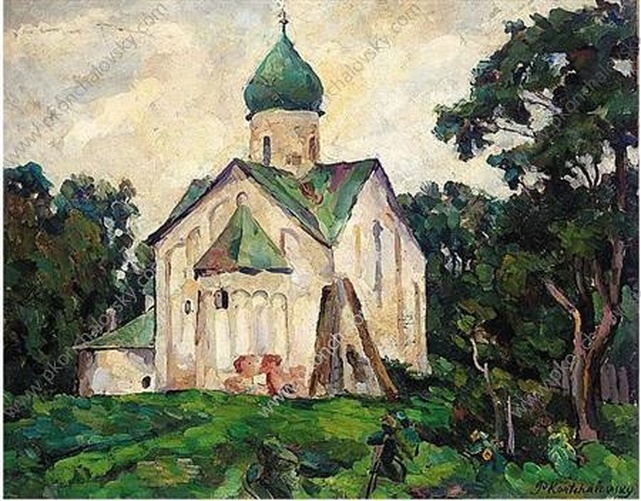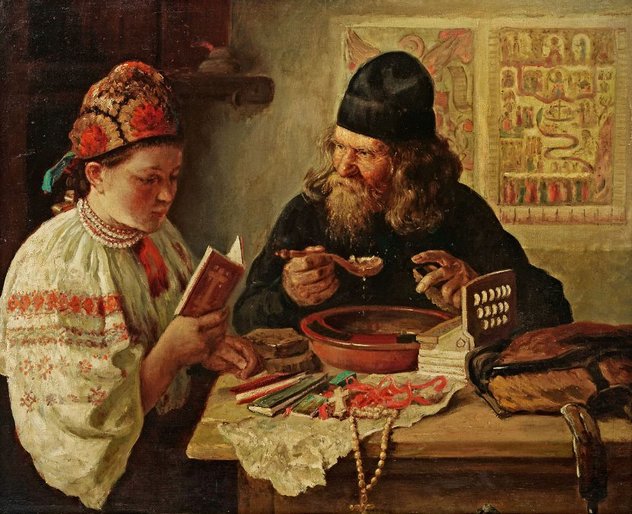October 2015
After retirement and a long career as a social worker for the State of New Jersey, I reinvented myself as a poet and artist. After eight books of poetry and countless collages, I am expanding my traditional themes of people and place and social justice by writing prose and working in acrylics. Perhaps if I had been interested in pursuing this creativity years ago, I might have become wildly famous, or totally burned out by now. It's hard to say.
|
Editor's Note: In an email to me Nancy wrote:
These are two iconic Russian historical images. Makovsky (Rest on the Way from Kiev) was a member of the famed Society of Traveling Exhibits which displayed artwork in Russia and Eastern Europe in the late19th Century. Konchalovsky (Peter and Paul Church), late 19th C/20th C artist, created more than 5,000 works of art. If you wonder how I happened to write poetry about these images, I was on the hunt for auction catalogs that I could use as source material for my collages. I found Sotheby and Christie catalogs at a local flea market and cut many of them up, but I could not bring myself to destroy some of the Russian images, including these two. Instead they inspired me to write about them. |
Peter and Paul Church
Petr Petrovich Konchalovsky, oil on canvas, 1925
Petr Petrovich Konchalovsky, oil on canvas, 1925
In March, 1917, Tsar Nicholas II abdicated in Pskov, a city rich in parish churches, including Peter and Paul built in 1373.
Among so many churches, why did the artist select
this quaint edifice isolated among thick summer foliage?
He limits his color palate—glints of grey, red, and brown,
but dabs and clumps of green and white create the surface texture.
The green onion-dome and lower roofs of the church
mimic the hues of trees and grass
while white stucco walls merge with the cloud-driven sky.
The bells toll as they have for centuries
in this glade
this city
this country which has given
thumbs up or down
to so many martyrs and patriots.
Yet, within these walls, many seek sanctuary.
Church, earth, and sky. Just that.
-first published in Segue and in the author’s book, On Location (March Street Press, 2011)
Among so many churches, why did the artist select
this quaint edifice isolated among thick summer foliage?
He limits his color palate—glints of grey, red, and brown,
but dabs and clumps of green and white create the surface texture.
The green onion-dome and lower roofs of the church
mimic the hues of trees and grass
while white stucco walls merge with the cloud-driven sky.
The bells toll as they have for centuries
in this glade
this city
this country which has given
thumbs up or down
to so many martyrs and patriots.
Yet, within these walls, many seek sanctuary.
Church, earth, and sky. Just that.
-first published in Segue and in the author’s book, On Location (March Street Press, 2011)
Rest on the Way from Kiev
Vladimir Egorovich Makovsky, oil on canvas, 1888
Vladimir Egorovich Makovsky, oil on canvas, 1888
In the chiaroscuro of the room, two players:
the itinerant old monk stopping
on his way from the monastery in Kiev
and a young provincial woman.
They sit across from each other
at the corner of the rough-hewn table,
a large wooden bowl of food and silver salt box
set in front of him, a mark of her generosity.
Prayer books, beads, and crosses
in a jumble on white cloth.
He, bearded, wool skull cap, dark clothes, dirty
fingernails, a raised spoon in his hand, leans
as if he is speaking, perhaps trying to woo her
with tales of his wanderings from shrine to shrine
raising alms for the dedication of new churches.
She, wearing a delicately embroidered blouse,
bright-colored head covering tied with green ribbon,
looks intently at the prayer book she is holding.
Perhaps she is reading a passage, entertaining him
as is the custom, rather than
listening as if she’s not yet convinced.
He may be a charlatan, but she accepts him
as he is, offers him a straw pallet in the barn,
blanket and pitcher of water to wash.
At dawn, she hands him a cup of steaming tea.
Then he’s on the road with his satchel; she’s late
to milk cows eager to be let out to pasture.
-first published in the author’s book, On Location (March Street Press, 2011)
the itinerant old monk stopping
on his way from the monastery in Kiev
and a young provincial woman.
They sit across from each other
at the corner of the rough-hewn table,
a large wooden bowl of food and silver salt box
set in front of him, a mark of her generosity.
Prayer books, beads, and crosses
in a jumble on white cloth.
He, bearded, wool skull cap, dark clothes, dirty
fingernails, a raised spoon in his hand, leans
as if he is speaking, perhaps trying to woo her
with tales of his wanderings from shrine to shrine
raising alms for the dedication of new churches.
She, wearing a delicately embroidered blouse,
bright-colored head covering tied with green ribbon,
looks intently at the prayer book she is holding.
Perhaps she is reading a passage, entertaining him
as is the custom, rather than
listening as if she’s not yet convinced.
He may be a charlatan, but she accepts him
as he is, offers him a straw pallet in the barn,
blanket and pitcher of water to wash.
At dawn, she hands him a cup of steaming tea.
Then he’s on the road with his satchel; she’s late
to milk cows eager to be let out to pasture.
-first published in the author’s book, On Location (March Street Press, 2011)
©2015 Nancy Scott


